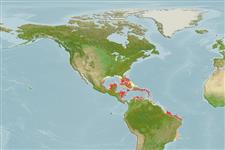Demospongiae |
Poecilosclerida |
Microcionidae
Environment: milieu / climate zone / djupintervall / distribution range
Ekologi
; brackvatten; djupintervall 1 - 35 m (Ref. 108813). Tropical
Western Central Atlantic.
Length at first maturity / Size / Weight / Age
Könsmognad: Lm ? range ? - ? cm Max length : 15.0 cm H hane/ej könsbestämd; (Ref. 415)
Thinly encrusting: 0.2 - 0.4 cm thickness to lobate, ramose, palmate or flabellate, with thin branches reaching 10 - 15 cm in height. Very characteristically colored externally orange to red with yellowish tinges. Very smooth, somewhat slippery surface. Soft and compressible in consistency (Ref. 415).
Species grows on mangrove prop roots and seagrass beds (Ref. 86836). They are found in coral reefs and rocky bottoms (Ref. 83919).
Life cycle and mating behavior
Könsmognad | Reproduktion | Lek | Eggs | Fecundity | Larvae
Members of the class Demospongiae are hermaphroditic. Life cycle: The zygote develops into parenchymella larva (free-swimming) before settling down on a substrate where it grows into a young sponge.
Collin, R., M.C. Díaz, J. Norenburg, R.M. Rocha, J.A. Sánchez, M. Schulze, A. Schwartz and A. Valdés 2005 Photographic identification guide to some common marine invertebrates of Bocas Del Toro, Panama. Caribbean Journal of Science. 41(3):638-707. (Ref. 415)
IUCN Red List Status
(Ref. 130435: Version 2025-1)
CITES status (Ref. 108899)
Not Evaluated
Not Evaluated
Threat to humans
Harmless
Human uses
| FishSource |
Verktyg
Ytterligare information
Trophic EcologyFood items (preys)
Födosammansättning
Födointag
Predatorer
Population dynamicsTillväxt
Max. ages / sizes
Length-weight rel.
Length-length rel.
Length-frequencies
Mass conversion
Abundans
PhysiologySyreförbrukning
Human RelatedStamps, coins, misc.
Internet-källor
Estimates based on models
Preferred temperature
(Ref.
115969): 26.3 - 28.3, mean 27.2 (based on 315 cells).
Fishing Vulnerability
Low vulnerability (10 of 100).
Price category
Unknown.
